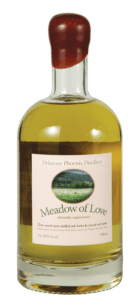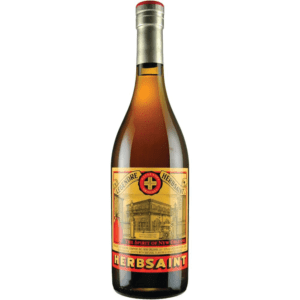
There’s a family of herbal, often bitter, green-hued spirits and liqueurs that have a divisive effect among tipplers. Rarely are these verdant nectars enjoyed as-is; more often, they serve as barely-there top notes in high-end cocktails. Sometimes they’re used merely to rinse the glass before a mixed drink is poured, so strong is their presence. The going theory is that the addition of other flavors soften their impact—which makes them the perfect candidates for a cheese tasting.
The most well-known of these green elixirs is absinthe, followed by the secretive, two-toned Chartreuse and the elusive Alpine génépy. At once similar in flavor yet vastly different in nuance, these bottles often get relegated to the least-trafficked shelves of the liquor store, sandwiched between other hard-to-classify products. Their color might have something to do with it, or the fact that so few American makers have taken a stab at the centuries-old European recipes, which are historically closely guarded. Call them the washed-rind cheeses of the spirit world: long dismissed stateside as too French, they’re the party guests no one’s sure were actually invited, exuding mystery in the corner.
Fortunately, just as the American artisan cheese movement has produced plenty of its own stinky cheeses, we’ve seen some little hints of green popping up across these amber waves of grain (and hops and corn and grapes).
No matter where they’re made, the strongest flavors in these bottles are easily identified: anise seed plays a starring role, followed by chamomile and fennel, then less familiar flavors like angelica, hyssop, and veronica. Absinthe and its cohorts owe the top notes of their bracing flavor profiles to wormwood, a family of flowering perennials that grow in temperate, mountainous terrain. Chlorophyll is typically responsible for the drinks’ natural emerald green color (though more than a few makers are known to synthetically dye their distillates). Collectively, these drinks make for excellent palate-cleansers; but to those unfamiliar, taking a sip of unadulterated absinthe or génépy can feel like getting gobsmacked by a shovelful of ice-cold licorice.
In other words, they’re a lot to handle on their own.
The unusual color and startling flavor aren’t the only reasons these spirits have historically gotten the side eye. Absinthe especially has been blamed throughout history for insanity, psychosis, depression, depravity, suicide, and murder; imbibers commonly reported visions of a green fairy maiden after two or three rounds. Contributing to absinthe’s unsavory reputation was its popularity among the more lurid characters of the 19th and early 20th centuries. Edgar Allen Poe and Aleister Crowley were said to enjoy the odd glass of la feé verte, and Henri de Toulouse-Lautrec—absinthe’s poster boy and frequent patron of the Moulin Rouge—was rumored to have hollowed out his walking stick so he could fill it with the stuff.
Grand wormwood—absinthe’s star ingredient—contains a chemical called thujone, which, if consumed in high doses, can cause hallucinations. It’s thujone’s purported psychoactive qualities that give absinthe a bad rap, but repeated studies have shown that the alcohol content of absinthe (around 90 proof) and the like would kill a person long before thujone would even register in the body. So all those ribald tales of murder and mayhem? Blame it on the alcohol.
When served well, and in the right proportions, these green beauties can redefine both aperitivi and après ski. The perfect foil to an absinthe or a Chartreuse is salt—which, as luck would have it, is one of the three ingredients needed to make cheese.

BERTHAUT TROU DU CRU + DELAWARE PHOENIX MEADOW OF LOVE ABSINTHE
While absinthe does not, in fact, cause a green fairy to materialize upon consumption, the chemical thujone contributes to an entertaining visual effect. When water is introduced to a liquid containing thujone, the mixture turns cloudy and opaque. A common preparation for absinthe involves gradually dripping the liquor through a sugar cube into a glass of water (1:5 ratio), where the two liquids join in a pearly-green spectacle the French call “la louche.” Hudson Valley-born Meadow of Love produces “rolling, milky cloud banks” when mixed with water, and offers up a hint of violets. Pair with a brothy little washed rind like Trou du Crou, because you can handle it.

PARMIGIANO REGGIANO, AGED 24 MONTHS + GREEN CHARTREUSE
In 1605 France, monks of the Order of Chartreuse received a mysterious manuscript containing a complex recipe for something called “The Elixir of Long Life.” Deciphering the recipe seemed more trouble than it was worth, until the Order’s apothecary took a stab at it and produced an herbal, complex liqueur that would prove to be more of a tipple than a tonic. Yellow (delicately sweet) and green (vegetal and bracing) Chartreuse are still produced today at the Chartreuse monastery in southeastern France, where it’s said that only two monks know all 130 herbs and plants used in the recipes. Yellow Chartreuse is most often used in cocktails, but the green variety packs more of a punch. Enjoy it well-chilled, over lots of ice, with paper-thin slivers of salty Parmigiano Reggiano.

CYPRESS GROVE HAZE REMIX + ST. GEORGE ABSINTHE VERTE
Goat cheese is often recommended as a pairing for absinthe, primarily because its smooth, subtly savory paste offsets the sting of wormwood. Cypress Grove’s Haze Remix with lavender and fennel pollen is an herbal spin on smoky Humboldt Fog, an undeniable crowd favorite. Pair with St.George Absinthe Verte, the first legal absinthe to be made and sold stateside. Mix one part absinthe with five parts water (regardez la louche!), add a dash of simple syrup, and chase each sip with a smear of Haze Remix on Melba toast. The fennel in the cheese will softly echo the anise-flavored spirit.

ALP BLOSSOM +HEIRLOOM GENEPY AND TONIC
Named for the variety of wormwood sometimes used to flavor it, génépy (orgenepì, in Italian) is sweet, slightly gentler than absinthe, and a crystal-clear olive green in color. Technically, any liqueur made with a wormwood that’s not grand wormwood (used in absinthe) can be called a génépy, but there are several Alpine makers that have claimed the name as their brand. Génépy was traditionally served to hikers in the French Alps to aid in blood vessel dilation, so it only seems fitting that it be enjoyed with an Alpine cheese—try a wedge of funky, floral Alp Blossom with an all-American G & T (génépy and tonic, of course) from Milwaukee-based Heirloom Liqueurs.

TOMME CRAYEUSE + HERBSAINT
We couldn’t bring up American absinthe and not mention New Orleans. Home of the Sazerac, technically the first true American cocktail, the bawdy Big Easy in the mid-1800s was a prime crucible for green fairy fever. However, by the 1930s, real absinthe was proving harder to find stateside, so two local veterans of World War I tried their hand at brewing it themselves. The resulting anise-flavored liqueur could not legally be called absinthe, as it did not contain the key ingredient grand wormwood. In a clever workaround, the makers christened it Herbsaint, which means “Sacred Herb,” and is almost a perfect anagram of “absinthe” (with a leftover ‘r’). Green as army fatigues, Herbsaint is still produced by the Sazerac Company in New Orleans, where it’s served regularly in an eponymous frappé. Like absinthe, Herbsaint loves anything salty and intense: alternate sips of this cocktail (see recipe below) with slices of a briny washed rind cheese.
The Orleanian
Ingredients
- 1 teaspoon simple syrup
- 3 dashes Herbsaint
- 2 ounces rye whiskey
- Lemon twist
Instructions
- Shake all ingredients in a cocktail shaker with ice. Strain into a coupe, then twist the lemon peel over the glass to express the oil.



